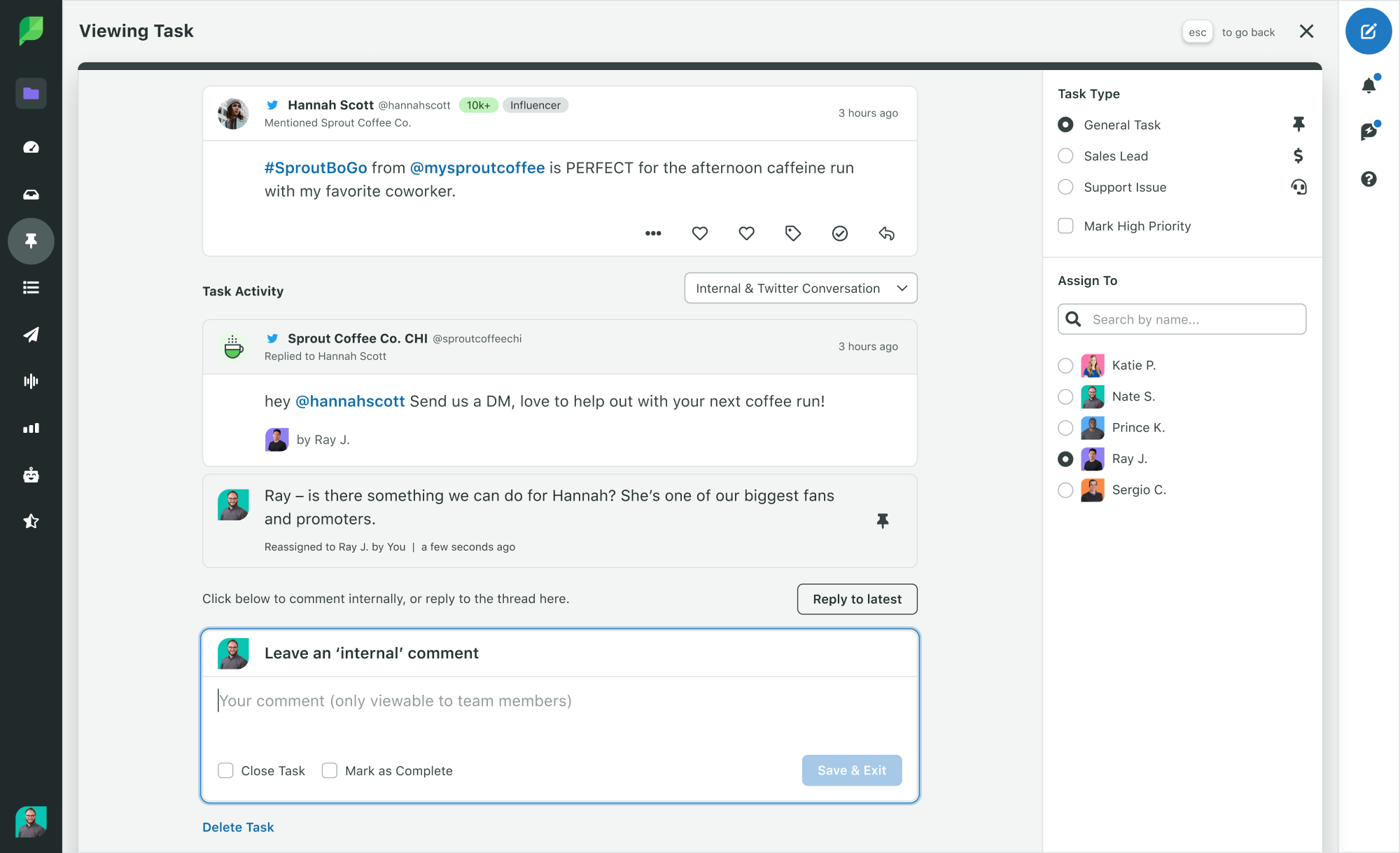Sprout Social para agencias
Desde la gestión de varios clientes en redes sociales para tiendas de marketing digital hasta equipos interinstitucionales a nivel empresarial, Sprout Social permite que centralizar los esfuerzos de redes sociales de las agencias desde una misma poderosa plataforma sea fácil y eficiente.
As mentioned at the beginning of this guide, today’s social agency landscape is as varied as the brands and client engagements they represent. From traditional PR and integrated digital groups to dedicated content production or community management teams, agencies of all types are brought on to handle a multitude of responsibilities within a business’ social program.
Whether providing full service social solutions or stepping in for a specific campaign or project, agencies understand how to deliver results. And within a sole social agency, each client engagement can call for a distinct set up—whether that’s one-to-many, many-to-one or collaborative.

Cuando los equipos de las agencias necesitan herramientas a fin de implementar estas iniciativas de redes sociales para sus clientes, usan Sprout Social. Con los conjuntos de herramientas de publicación, participación e informes de Sprout, las agencias pueden utilizar uno o combinar todos para satisfacer sus necesidades. Además, a medida que crecen las carteras de clientes y cambian los objetivos, la estructura flexible de cuentas y los permisos personalizados de Sprout hacen realidad la administración escalable de los clientes.
Let us show you the different ways Sprout can accommodate your agency’s working style.
Getting Set Up in Sprout
Getting your agency up and running in Sprout is quick and easy. It’s important to set parameters from the beginning so everyone understands their roles and responsibilities, and how they work together as a unit.
¡Si no has usado Sprout antes o no tienes actualmente una cuenta, puedes comenzar con una prueba gratis para experimentar los flujos de trabajo tú mismo!
Para conectar un perfil de redes sociales:
- Haz clic en
 , en la esquina superior derecha. También puedes conectar un perfil al hacer clic en
, en la esquina superior derecha. También puedes conectar un perfil al hacer clic en  > Configuración > Usuarios y perfiles de redes sociales y seleccionar + conectar tus perfiles de redes sociales arriba de la columna Tu empresa.
> Configuración > Usuarios y perfiles de redes sociales y seleccionar + conectar tus perfiles de redes sociales arriba de la columna Tu empresa. - Selecciona el Grupo al que pertenecerá el perfil en el menú desplegable En grupo .
- Selecciona la red que deseas agregar. Es posible que haya opciones adicionales para seleccionar según la red que hayas elegido.
- Click the button in the lower right corner of the Connect a Profile screen.
- You will be sent to the corresponding network’s site. Follow the prompts to authorize the profile.
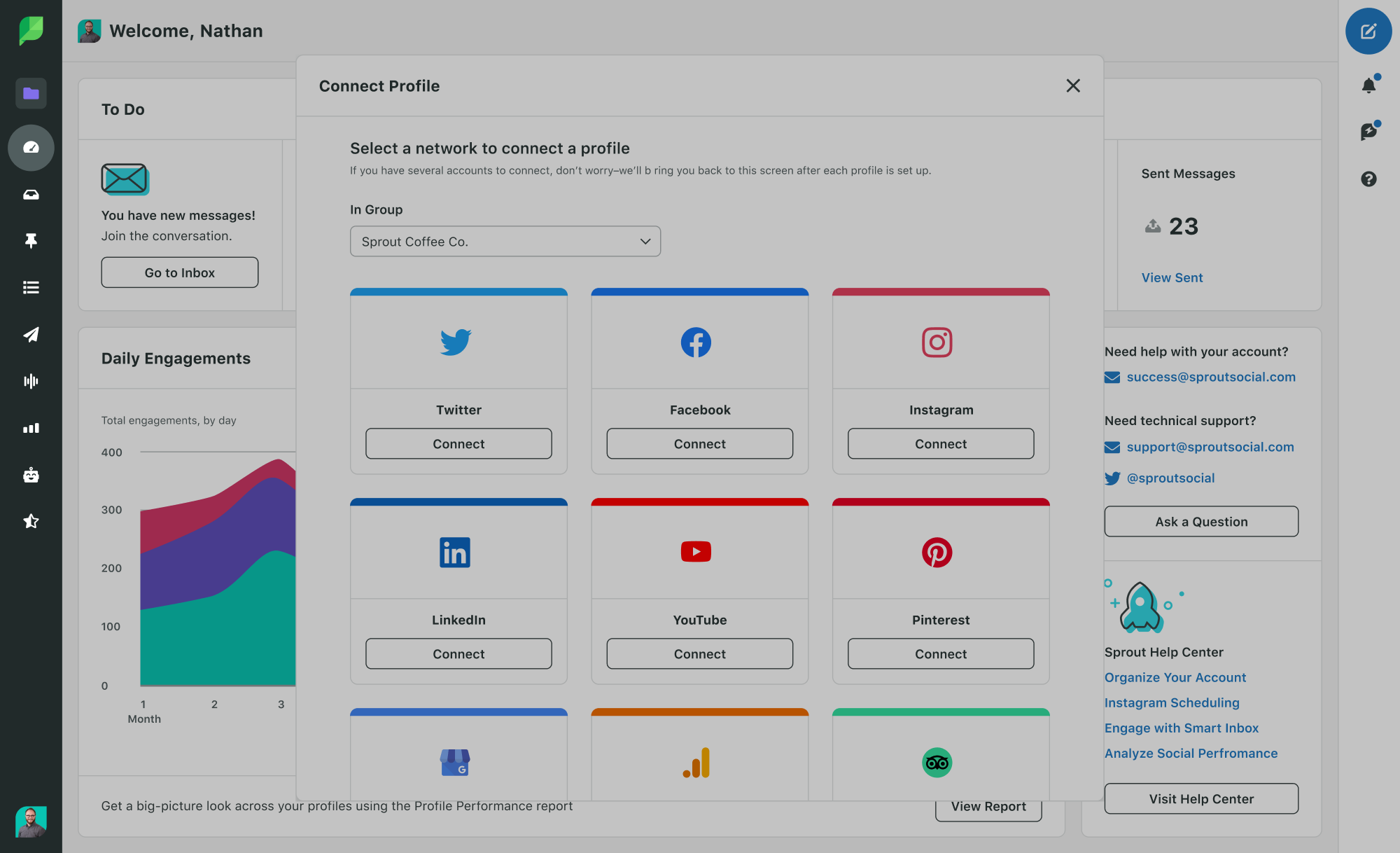
To add social representatives:
Invitar a un nuevo miembro del equipo
1. Haz clic en  el ícono ubicado en la esquina superior derecha de la aplicación. También puedes invitar a un usuario al hacer clic en
el ícono ubicado en la esquina superior derecha de la aplicación. También puedes invitar a un usuario al hacer clic en  > Configuración > Usuarios y perfiles de redes sociales y seleccionar + invitar a miembros nuevos al equipo arriba de la columna Tu empresa .
> Configuración > Usuarios y perfiles de redes sociales y seleccionar + invitar a miembros nuevos al equipo arriba de la columna Tu empresa .
2. Agrega el nombre y la dirección de correo electrónico del usuario que deseas invitar. Haz clic en  para añadir a varios usuarios.
para añadir a varios usuarios.
3. Elige el(los) Grupo(s) y el acceso al perfil asociado para el(los) usuario(s). Después de hacer clic en Enviar invitaciones, el(los) usuario(s) recibirá(n) una notificación de invitación por correo electrónico.
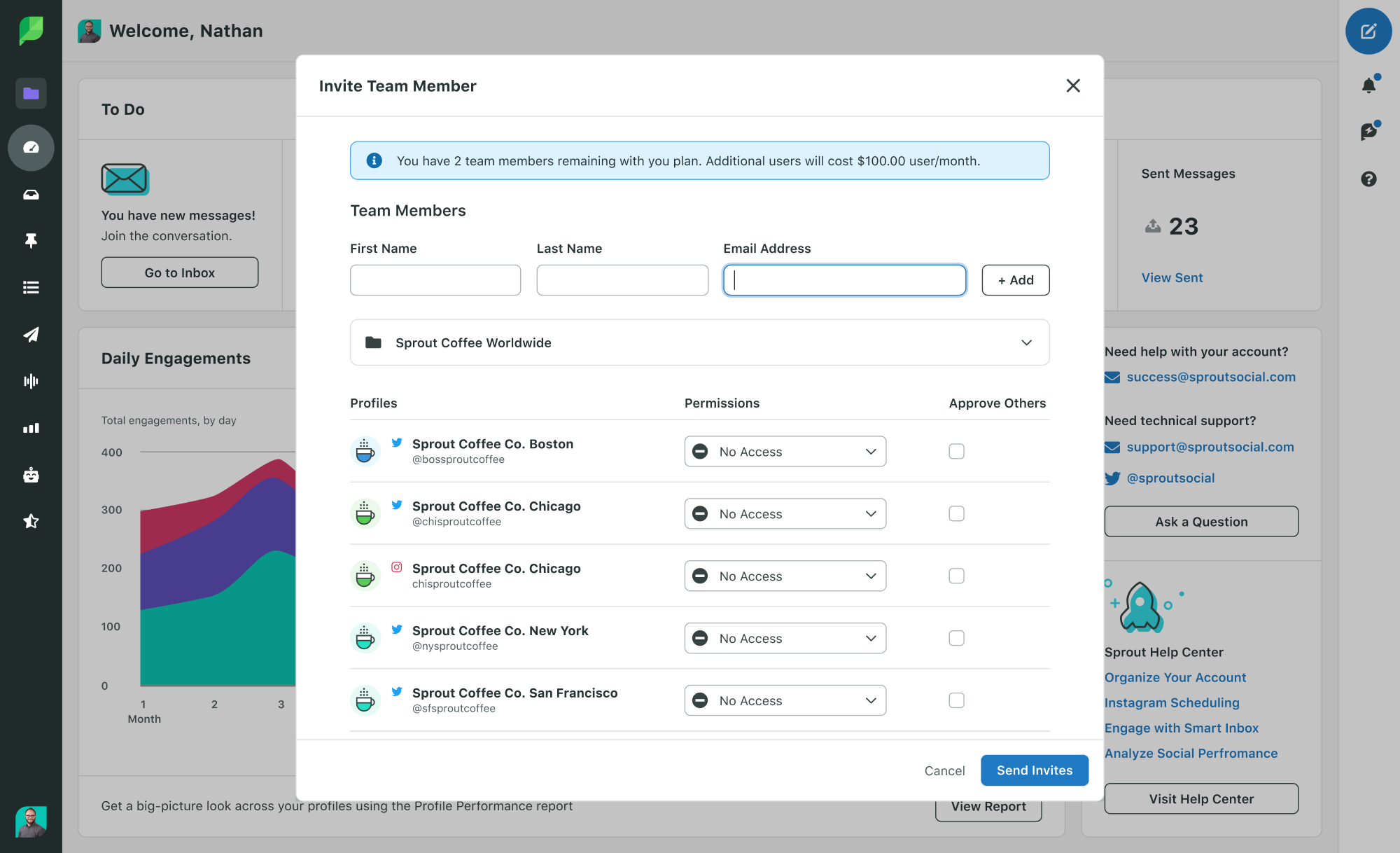
Grupos
You can grant team members and client-side contacts access to specific profiles, depending on their responsibilities, then organize those profiles into Groups. Using the flexible Group structure to set up separate, secure client environments makes managing a large client portfolio in Sprout safe and easy. Groups ensure publishing security and align individual users to applicable reporting insights.

Crear un grupo
1. Existen varias maneras de crear un Grupo nuevo. Para usar el primer método, haz clic en el nombre del Grupo actual para que aparezca el menú desplegable del Grupo. Selecciona + Agregar grupo en la parte inferior del menú desplegable para crear un Grupo nuevo.

2. Use the second method by first navigating to Settings » Users & Social Profiles, then click +create new group.
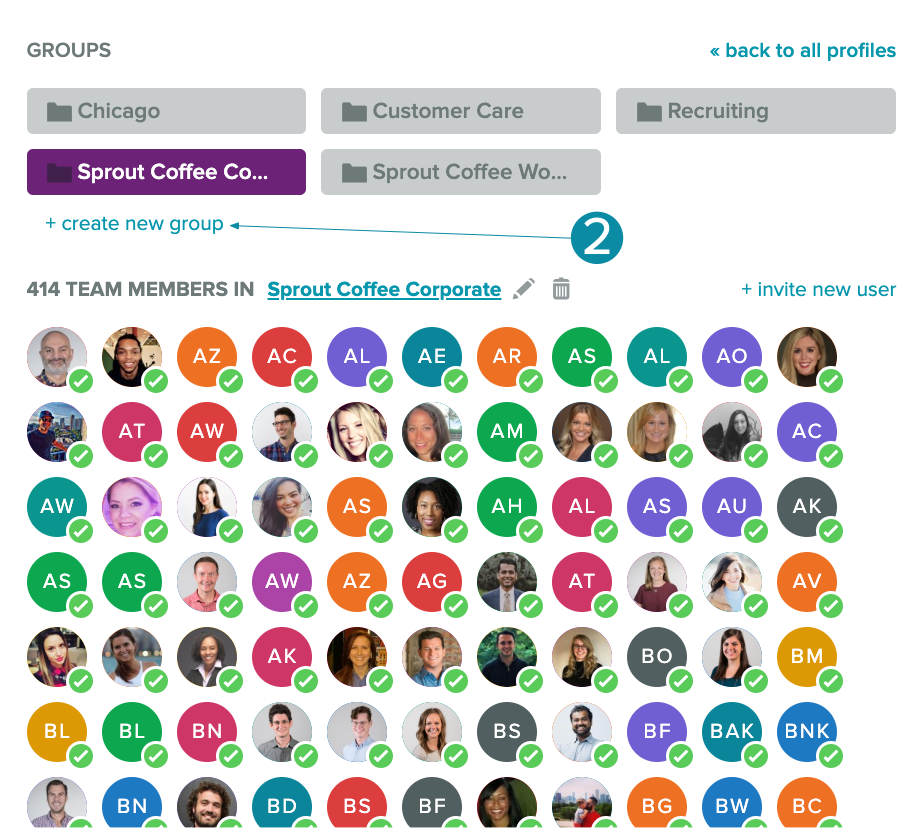
3. Después de usar uno de los métodos anteriores, elige crear un Grupo nuevo asociado con un perfil de redes sociales que se ha agregado recientemente o crear un Grupo a partir del perfil de redes sociales existente en Sprout.
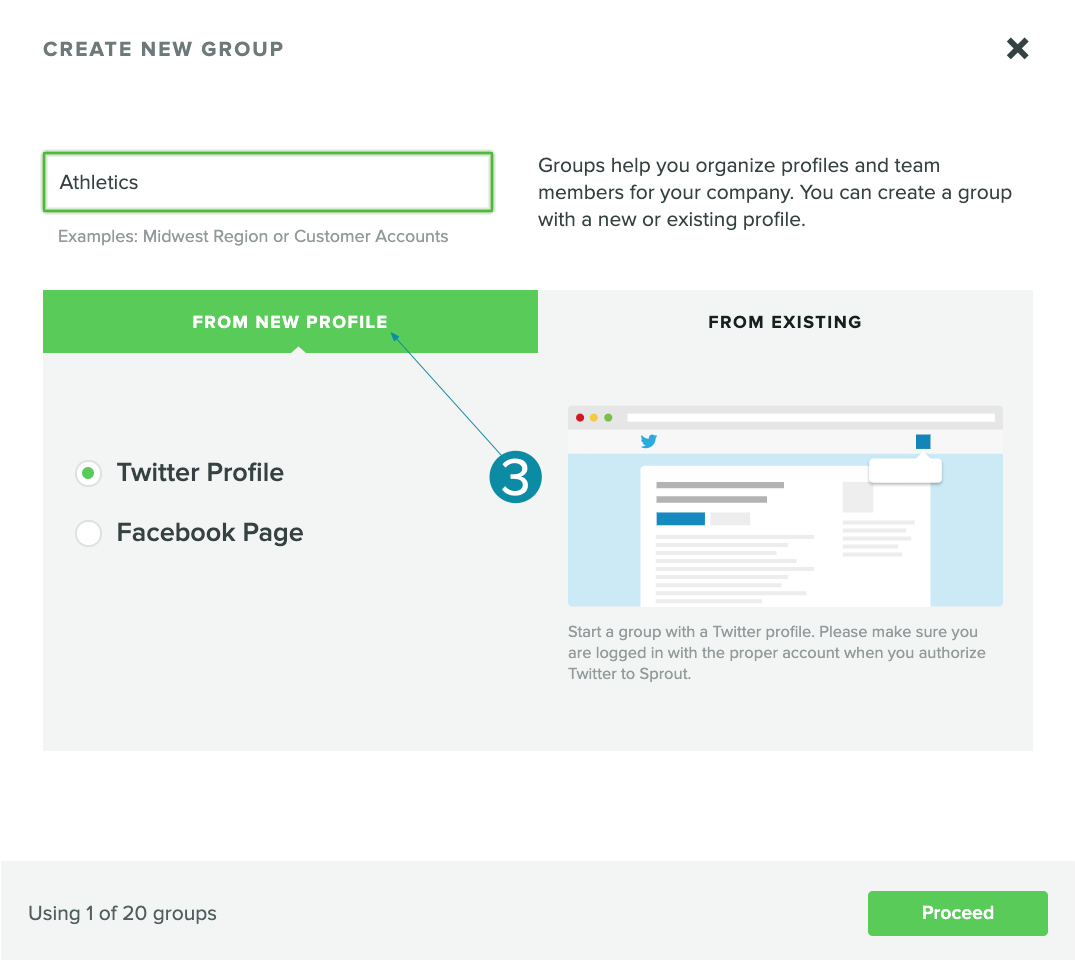
User Settings & Permissions
Setting permissions at the user level ensures the right person is handling the right message and assets. You have two opportunities to configure permissions: when inviting a new user or by going to individual settings screens for Users & Social Profiles and Asset Library. You can configure permissions based on publishing, reporting and administrative access to align with your agency’s and client’s responsibilities.

Agency Use Case 1: Full-Service Solutions
- Agency type: Full service social media marketing
- Client engagement: One-to-many
- Agency set up: A mid-sized agency with a client portfolio of local and regional brands works in teams of social strategists and Community Managers. Each Community Manager is responsible for fully managing social programs on behalf of four client brands each.
- How Sprout powers the agency: Managing social media for all your clients is easy using Sprout. Your team can publish, engage and analyze all from one platform.
Para aprovechar al máximo el contenido publicado, los administradores de la comunidad usan el Programador para publicar mensajes urgentes en un horario específico o bien, usan ViralPost para garantizar que la audiencia de tu cliente vea el contenido en el momento óptimo para la participación.
Monitor and engage with incoming messages across all client profiles and networks using the Smart Inbox. Filter the inbox to concentrate on certain profiles, networks or message types, and mark messages as complete as you work towards inbox zero.
The mobile apps enable each Community Manager to stay connected even while on the go; team members can publish and engage right from their phone.
Use Case 2: Campaign Solutions
- Agency type: Campaign marketing / Campaign management
- Client engagement: Many-to-one
- Agency set up: A large global agency with a client portfolio of international brands works in teams that are responsible for managing social campaigns on behalf of each client.
- How Sprout powers the agency: Social-driven campaigns are, by nature, high-touch from strategic planning through execution. Sprout enables teams to gather strategic insights during the planning phase, manage customer engagements during execution and analyze results post-campaign.
Before your team starts ideation for a client campaign, the analyst uses the Twitter Listening Report to measure keyword volume in order to inform the campaign’s hashtag and creative strategy. Client approvals are streamlined using the Message Approval workflow, where stakeholders can approve or reject with feedback.
When executing the campaign, the team uses the Asset Library, Message Tagging and Content Calendar to plan and organize outgoing social posts. Throughout the lifecycle of the campaign, the team also uses Message Tagging to categorize incoming messages, like those using the dedicated hashtag.
Once the campaign wraps, the analyst uses the Tag Report to track volume, determine sentiment and analyze overall campaign performance to report back to the client.
Use Case 3: Content Strategy Solutions
- Agency type: Content marketing
- Client engagement: Collaborative
- Agency set up: An agency with a client portfolio of national brands appoints a content marketing team to each client project. Each content team is responsible for planning, creating and executing content marketing strategies on behalf of each client.
- How Sprout powers the agency: Content, context and audience are the keys to a successful content strategy.. Sprout’s publishing toolset enables agency teams to create and publish content tailored to specific platforms and audiences.
As your content team starts to create content, they use Compose to draft messages, including imagery from the Asset Library, then apply audience targeting to ensure the client’s messages reach the right audience.
Client approvals are streamlined using the Message Approval workflow, where stakeholders can approve or reject with feedback. Once the messages are approved and scheduled, the team can identify publishing gaps using the Content Calendar, and repeat the process to fill those holes.
The Sent Messages Report enables the team to analyze the content’s performance and adjust the content strategy as needed. Export the report to PDF for a presentation-ready version for your client or select the CSV file to further analyze specific KPIs and data points.
Use Case 4: Community Management Solutions
- Agency type: Community management and engagement
- Client engagement: One-to-many/Collaborative
- Agency set up: A niche agency that focuses on multi-location businesses manages a portfolio of 25 franchise brands which maintain hundreds of local, regional and national social profiles. Each project team is responsible for managing customer care on behalf of the client’s entire portfolio of social properties.
- How Sprout powers the agency: Reactive communication and customer care is vital to building and maintaining social relationships. Agencies use Sprout’s engagement toolset to discover, manage and address incoming messages on behalf of their clients.
The Smart Inbox is where your account team will monitor and engage with incoming messages across profiles and networks. Set up Brand Keywords so Community Managers can find and engage in conversations that are important to its client—such as campaign hashtags, location check-ins or even competitor names—but may not include direct mentions.
As messages stream into the inbox, Community Managers collaborate with each other or with the client by assigning messages as Tasks to ensure the right person is responding to the message. Community Managers Mark messages as complete as the account team works toward inbox zero.
Analysts use the Engagement Report to track response rates and times to meet the client’s engagement KPIs, as well as report on those efforts.
Use Case 5: Analytics Solutions
- Tipo de agencia: Estadísticas de las redes sociales
- Client engagement: Many-to-one
- Configuración de agencias: Una agencia con una cartera de clientes de marcas nacionales designa a un equipo de analistas por cuenta de cliente, que es responsable de establecer y analizar la estrategia en las redes sociales en nombre de cada cliente.
- Cómo impulsa Sprout a la agencia: Si tu agencia impulsa la estrategia en las redes sociales y su ejecución en nombre de tus clientes, necesitas datos para imponer su efectividad. El paquete de informes de Sprout le permite a tu agencia demostrar su utilidad y usar ideas para modificar tu estrategia.
The Group Report is a high-level overview that provides aggregate data across social networks so your client has a better understanding of social efforts as a whole.
Pair the Group Report with the network profile reports—Twitter Profiles, Facebook Pages, Instagram Profiles and LinkedIn Company Pages—for an in-depth look at specific social channels. Use these reports to demonstrate growth and audience behaviors across all channels and profiles.
Export the reports to PDF for a presentation-ready version for your client or select the CSV file to further analyze specific KPIs and data points.
Use Case 6: Customer Service Solutions
- Agency type: Customer service
- Client engagement: One-to-many
- Agency set up: A mid-sized customer service agency with a client portfolio of national brands appoints Customer Advocate teams to manage customer care around the clock for each client.
- How Sprout powers the agency: Creating a wonderful customer experience is important for agencies focusing on customer service. Sprout’s customer service toolset enables you to execute and analyze your efforts.
The Smart Inbox is where advocacy teams monitor and engage with incoming messages across profiles and networks. As messages stream into the inbox, the Customer Advocate Lead collaborates with the Customer Advocates or the client by assigning messages as Tasks to ensure the right person is responding to the message.
Account Directors use the Task Performance Report to analyze Tasks usage and completion between teams and advocates. Account Directors use the Team Report in conjunction to track their team’s social performance with reply metrics by individual, across all profiles and across specific profiles.
Export the reports to PDF for a presentation-ready version for your client or select the CSV file to further analyze specific KPIs and data points.
The Solution for Agencies
In today’s world, social campaigns and client engagements vary greatly; Sprout thrives in all types of agency environments. Agencies use Sprout to work on behalf of—and collaborate with—their clients. Sprout enables agencies and teams to plan and publish campaigns, manage social communities and conversations, and measure performance to demonstrate real results so they can win new business.

